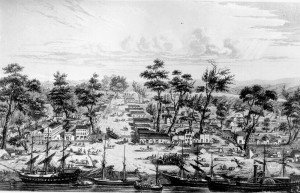In 1849, there were essentially two types of people who frequented Sacramento California. Those who worked hard all day digging or panning for gold up in the Sierra Nevada foothills, and those selling things to these prospectors. Both would make a lot of money although the majority would have been those who sold to the miners. It was more of a sure thing and the prices received by merchants in such a remote region could be astonishing.

The Eagle Theater in Sacramento Old Town was the first permanent theater structure built in the state of California. The structure was simply wood frame and canvas located behind a gambling tent. To enter the Eagle Theater one would had to walk through the gambling tent where, certainly more than once, a miner lost some gold dust between the entrance of the tent and the entrance of the theater. In retrospect, it probably was one of the best marketing ideas of 1849. At every turn there was opportunity for the gold miners to spend their money.
The Eagle Theater which supposedly cost an amazing $30,000 to build (wood and canvas), opened in September of 1849. The high cost of building such a flimsy structure was a direct result of the shortage of building materials around the gold country. Other items such as food, clothes, etc were selling at astronomical prices. Opening a theater was a fairly sure way to make money in Sacramento at that time. The miners had spent most of their non-mining hours either gambling, drinking and in most cases doing both at the same time. Even that routine can get old. Not that they ever really gave up the gambling and imbibing, but something new was needed for miners to spend their time and their gold dust. There were enough non mining people around Sacramento and the gold fields trying to answer that question. A different kind of entertainment was needed. The answer was theater, although theater at that particular time and place could be open to interpretation. Nevertheless, good or bad theater, it was entertainment.
The very informative book, Women of the Gold Rush by author Elizabeth Margo, describes what unfortunately happened to the Eagle Theater. The Eagle Theater was created by the Eagle Stock Company which was a first for California. As mentioned above, theater patrons would pass through the Round Tent gambling saloon to enter the theater. The Eagle Stock Company began in early fall with a series of plays such as The Bandit Chief.

California falls and winter can be quite wet. It’s the rainy season in the state and it’s also a time when gold prospectors were often idle. The theater did two things. It offered entertainment when the miners needed something to do and it also was a way to get shelter from the rain.
In 1849, it rained during the entire fall season, rained all November and December and rained even heavier during January 1850. On one rainy evening in January the Sacramento River rose so much that water came seeping through the floor. During the play’s second act the audience was standing on the benches. By the time the play concluded, the audience of miners were virtually hanging from the rafters in the gallery. What occurred was that the Eagle Theater actually became a part of the newly widened Sacramento River. What was the short lived Eagle Theater was now part of the Sacramento River. The elements did what the critics could never do. Never again would a Sacramento theater be at that location. Amazingly, the Eagle Stock Company held fast and continued to put on performances for several more nights. The audience hung from the rafters over the part of the river that was serving as the Eagle Theater. This gives you an idea of how badly entertainment was needed and accepted. Flooding in Sacramento during January 1850 damaged a wide area of the Sacramento waterfront. When all was said and done, only a portion of the theater remained intact. New owners rebuilt the theater about 200 feet inland and renamed it the Tehama Theater. Several of the flooded out performers from the Eagle Stock Company found work later in San Francisco’s growing theater scene. The Eagle Theater would be no more.
This may very well have been the only instance that a theater was literally washed away by a raging river. Certainly, it was the only instance in California. many theaters in the old California mining towns were destroyed by fire. This happened in San Francisco several times in the early 1850’s and in Nevada City California. The first mining camps and towns were built with wood. Fires swept through many of these towns and virtually destroyed everything. After each fire, the towns were rebuilt. Brick eventually became the preferred material. This is why today when you take a trip to many of these towns like Nevada City, Grass Valley and Senora, brick structures are found everywhere.
Two California gold country articles you’ll find interesting are about the gold town of Auburn California and the prosperous town of Nevada City California and it’s famous theater.
Another excellent book regarding theater during the California Gold Rush is Anybody’s Gold by author Joseph Henry Jackson. The book includes a good deal of information about the performers who worked the early California theaters.
Today, the restored Eagle Theater structure is owned by the California Parks and Recreation Dept. Fund raising for the restoration is credited to the Junior League and it’s efforts to have to California legislature to provide $75,000 for the project. The Eagle Theater today is operated by the California State Railroad Museum which is about one block away. The address is 925 Front Street in Old Town Sacramento California.
